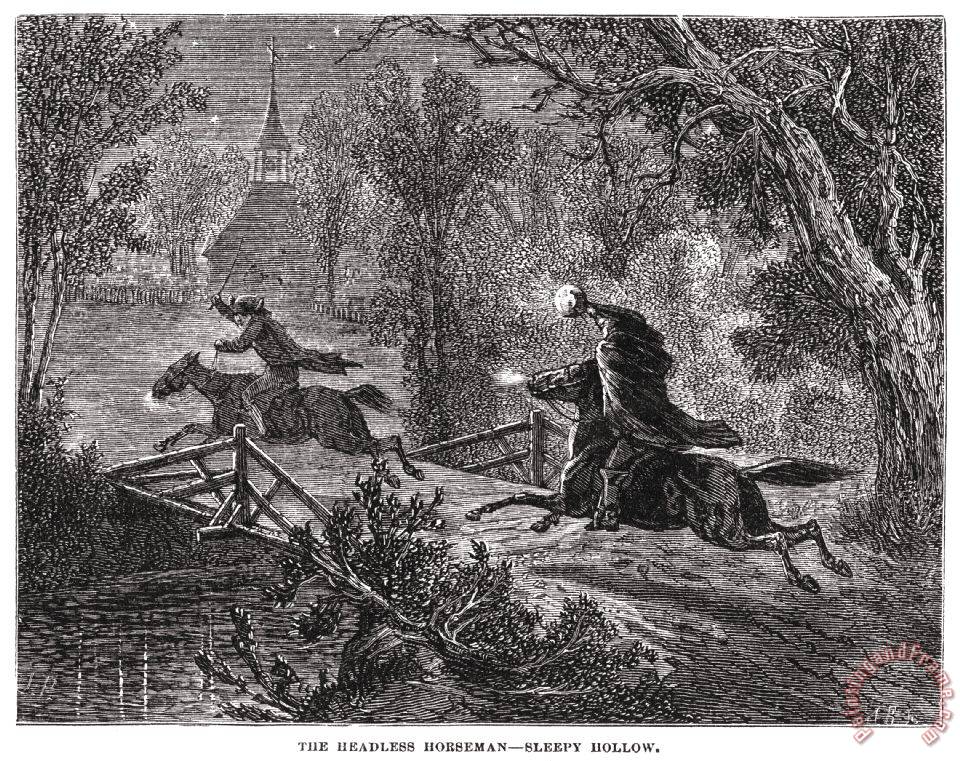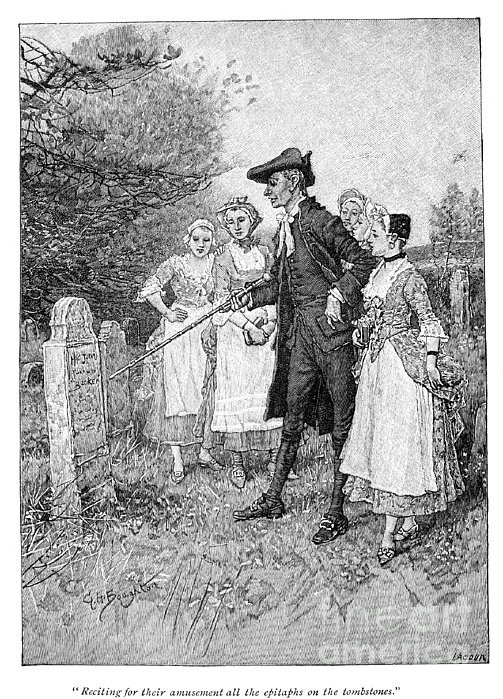
Ever since I was a kid, I’ve remembered the scary story about the Headless Horseman. But tonight I discovered something that I never knew before. I’d been reading the free Kindle edition of Washington Irving’s The Sketchbook of Geoffrey Crayon, a collection of essays and stories that he’d published together in 1820.
And its very last story is the original Legend of Sleepy Hollow…
Washington Irving also published “Rip Van Winkle” in that same collection (attributing both stories to a fake Dutch historian that he’d been using as an alter ego — Diedrich Knickerbocker). But if you read Irving’s book all the way to the end, there’s an even bigger surprise. On its final page, Washington Irving reveals that “an old farmer who’d been down to New York” brings word that Ichabod Crane is still alive!
Though the townsfolk of Sleepy Hollow believed he’d been taken by the Headless Horseman, the truth is that the gangly schoolmaster “had left the neighborhood, partly through fear of the goblin…and partly in mortification at having been suddenly dismissed by the heiress…” When the townspeople found a pumpkin shell by the Sleepy Hollow bridge, next to Ichabod’s hat, they’d just assumed this meant a goblin had carried him away. But in fact — according to that farmer — Ichabod “changed his quarters to a distant part of the country; had kept school and studied law at the same time, had been admitted to the bar, turned politician, electioneered, written for the newspapers, and finally had been made a justice…”

It’s nice that there’s a happy ending after all. In fact, Irving’s whole book is a celebration of travel, the joys of discovering new local customs, and especially the magic of rural life. There’s stories about neighborhood characters and Christmas celebrations, grand old manors and peaceful villages. Many of the “sketches” are about England, and there’s even another ghost story set in Europe — The Spectre Bridegroom — which also turns out to have another witty explanation for its supernatural proceedings, and a surprisingly cheerful ending. And of course, the same could also be said for The Legend of Sleepy Hollow.
I once wrote an essay about the original story, noting that it’s really a story about the legend itself. In a way, it’s Washington Irving’s own tribute to rural America, with its close-knit communities and local superstitions. The bounties of its farmland might be coveted by an outside schoolmaster, but in the end he couldn’t successfully navigate himself into their society. But Ichabod was too lovable of a character to leave lost in a goblin limbo — without a few sentences about where he really ended up — safe and sound, far away, where he really belonged.
And I was particularly moved to hear this, because Walt Disney’s version of this story scared the heck out of me as a kid. It doesn’t really clarify for younger audiences that the headless horseman was just one of the locals who’d dressed up in a costume. (Brom Bones had been jealous of the schoolmaster’s advances on a local heiress, Irving makes clear in his original story.) The heiress, it’s implied, had been leading on Ichabod, to drive Brom into a jealous frenzy. So Brom dresses up like the headless horseman that night — carrying a pumpkin under his arm, which he harmlessly throws at the schoolmaster at the end of his ride.
In Washington Irving’s story, Ichabod then just tumbles to the ground, and hears all the hoofbeats galloping by. But in the Disney version, it’s a flaming pumpkin that’s thrown at his head. And all throughout their animated chase, that vicious horseman had kept swinging a sword at poor Ichabod. No wonder that cartoon is so frightening to children!
Plus, Walt Disney even changed the story so it all happens on Halloween night!
But Washington Irving made sure his readers knew what really happened that autumn in Sleepy Hollow. After the superstitious Ichabod vanished, Brom married that heiress himself. And from then on, every time someone described the mysterious disappearance of Ichabod Crane, Brom Bones would “look exceedingly knowing – and always burst into a hearty laugh at the mention of the pumpkin…
“[W]hich led some to suspect that he knew more about the matter than he chose to tell.”
Read the original! Click here for the free Kindle edition
of Washington Irving’s “The Sketchbook of Geoffrey Crayon”